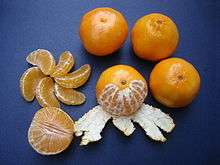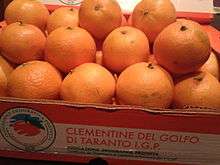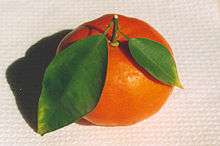Clementine
A clementine (Citrus × clementina) is a tangor, a citrus fruit hybrid between a willowleaf mandarin orange (C. × deliciosa) and a sweet orange (C. × sinensis),[1][2][3] named for its late 19th-century discoverer.[4] The exterior is a deep orange colour with a smooth, glossy appearance. Clementines can be separated into 7 to 14 segments. Similar to tangerines, they tend to be easy to peel. They are typically juicy and sweet, with less acid than oranges.[4] Their oils, like other citrus fruits, contain mostly limonene as well as myrcene, linalool, α-pinene and many complex aromatics.[5]
| Clementine | |
|---|---|
 Five clementines whole, peeled, halved and sectioned | |
| Species | Citrus × clementina |
| Hybrid parentage | Mandarin orange × sweet orange |
History

The clementine is a spontaneous citrus hybrid that arose in the late 19th century in Misserghin, Algeria, in the garden of the orphanage of Brother Clément Rodier, for whom it would be formally named in 1902.[6][7][8] Some sources have attributed an earlier origin for the hybrid, pointing to similar fruit native to the provinces of Guangxi and Guangdong in present-day China,[9] but these are likely distinct mandarin hybrids,[10] and genomic analysis of the clementine has shown it to have arisen from a cross between a sweet orange (Citrus × sinensis) and the Mediterranean willowleaf mandarin (Citrus × deliciosa), consistent with Algerian origin.[1][2]
There are three types of clementines: seedless clementines, clementines (maximum of 10 seeds), and Monreal (more than 10 seeds). Clementines resemble other citrus varieties such as the satsuma and tangerines.[11]
Cultivation
Clementines differ from other citrus in having lower heat requirement, which means the tolerance to fruit maturity and sensitivity to unfavorable conditions during the flowering and fruit-setting period is higher. However, in regions of high total heat, the Clementine bears fruit early; only slightly later than satsuma mandarins. These regions such as North Africa, Mediterranean basin, and California, also favor maximizing the Clementine size and quality. As a result, the tastiest Clementines are from these hot regions.[12]
It was introduced into California commercial agriculture in 1914, though it was grown at the Citrus Research Center (now part of the University of California, Riverside) as early as 1909.[12] Clementines lose their desirable seedless characteristic when they are cross-pollinated with other fruit. In 2006, to prevent this, growers such as Paramount Citrus in California threatened to sue local beekeepers to keep bees away from their crops.[13]
Types
- Seedless – exists in North Africa. Seedless versions of the clementine are known as the common type (seedless or practically seedless). Common Clementines are very similar to the Monreal type; the two types are virtually identical in terms of tree specifics. The seedless Clementine tree is self-incompatible; which is why the fruit has so few or no seeds. In order to be pollinated, it needs to be cross-pollinated.[12]
- Monreal – exists in North Africa. The Monreal clementine can self-pollinate and has seeds. Monreal clementines are on average larger than the seedless variety, has a more abundant bloom and is sweeter.[12]
Varieties

- Algerian, the original Rodier cultivar.[14]
- Fina, a Spanish cultivar originally grown on a bitter orange rootstock that gave it superb flavor, but due to disease vulnerability is now grown on a broader range of rootstocks, affecting the flavor profile.[14]
- Clemenules or Nules – A popular, seedless, easy to peel clementine with a very pleasing sweet flavor. A mutation of the Fina variety, Nules is the most widely planted clementine in Spain, where it matures from mid-November to mid to late-January. Also widely planted in California, where it matures from October to December.[15] It produces seedless fruit that is larger than the Fina, but less sweet.[14]
- Clementine del Golfo di Taranto, a (practically) seedless Italian cultivar given Protected geographical indication (PGI) status by the European Union, produced around the Gulf of Taranto. They have a sweet flavour and an intense aroma.[16]
- Clementine di Calabria, another Italian PGI variety, grown in the Calabria region.[17]
| Country | (millions of tonnes) |
|---|---|
Production
In 2016, world production of clementines, mandarin oranges, tangerines and satsumas, reported as a group to FAOSTAT, was 32.8 million tons, led by China with 52% of the global total (table).[18] Producing more than one million tons each in 2016 were Spain, Turkey, Morocco, and Egypt.[18]
Nutrition
| Nutritional value per 100 g (3.5 oz) | |
|---|---|
| Energy | 198 kJ (47 kcal) |
12.02 g | |
| Sugars | 9.18 g |
| Dietary fiber | 1.7 g |
0.15 g | |
0.85 g | |
| Vitamins | Quantity %DV† |
| Thiamine (B1) | 7% 0.086 mg |
| Riboflavin (B2) | 3% 0.030 mg |
| Niacin (B3) | 4% 0.636 mg |
| Pantothenic acid (B5) | 3% 0.151 mg |
| Vitamin B6 | 6% 0.075 mg |
| Folate (B9) | 6% 24 μg |
| Choline | 3% 14 mg |
| Vitamin C | 59% 48.8 mg |
| Vitamin E | 1% 0.20 mg |
| Minerals | Quantity %DV† |
| Calcium | 3% 30 mg |
| Copper | 2% 0.043 mg |
| Iron | 1% 0.14 mg |
| Magnesium | 3% 10 mg |
| Manganese | 1% 0.023 mg |
| Phosphorus | 3% 21 mg |
| Potassium | 4% 177 mg |
| Selenium | 0% 0.1 μg |
| Sodium | 0% 1 mg |
| Zinc | 1% 0.06 mg |
| Other constituents | Quantity |
| Water | 86.58 g |
Entry in USDA Database | |
| |
| †Percentages are roughly approximated using US recommendations for adults. Source: USDA Nutrient Database | |
A clementine contains 87% water, 12% carbohydrates, and negligible amounts of fat and protein (table). Among micronutrients, only vitamin C is in significant content (59% of the Daily Value) in a 100 gram reference serving, with all other nutrients in low amounts.
Potential drug interactions
A 2017 study indicated that clementine phytochemicals may interact with drugs in a manner similar to those of grapefruit.[19]
See also
References
- Shimizu, Tokurou; et al. (2016). "Hybrid Origins of Citrus Varieties Inferred from DNA Marker Analysis of Nuclear and Organelle Genomes". PLOS ONE. 11 (11): e0166969. doi:10.1371/journal.pone.0166969. PMC 5130255. PMID 27902727.
- Wu, GA; et al. (2014). "Sequencing of diverse mandarin, pummelo and orange genomes reveals complex history of admixture during citrus domestication". Nature Biotechnology. 32 (7): 656–662. doi:10.1038/nbt.2906. PMC 4113729. PMID 24908277.
- Barkley, NA; Roose, ML; Krueger, RR; Federici, CT (2006). "Assessing genetic diversity and population structure in a citrus germplasm collection utilizing simple sequence repeat markers (SSRs)". Theoretical and Applied Genetics. 112 (8): 1519–1531. doi:10.1007/s00122-006-0255-9. PMID 16699791.
- Edible: An Illustrated Guide to the World's Food Plants. National Geographic. 2008. p. 73. ISBN 978-1-4262-0372-5.
- Ziegler, Herta (2007). Flavourings: production, composition, applications, regulations. Wiley, John & Sons, Incorporated. p. 203. ISBN 978-3-527-31406-5.
- Trabut, J. L. (1902). "L'hybridation des Citrus: une nouvelle tangérine "la Clémentine"". Revue Horticole. 74: 232–234.
- Bretó, M. P.; Ruiz, C.; Pina, J.A.; Asíns, M.J. (2001). "The Diversification of Citrus clementina Hort. ex Tan., a Vegetatively Propagated Crop Species". Molecular Phylogenetics and Evolution. 21 (2): 285–293. doi:10.1006/mpev.2001.1008. PMID 11697922.
- Laszlo, Pierre (2007). Citrus: a history. University of Chicago Press. pp. 23–24.
- Saunt, James (January 1, 2000). Citrus Varieties of the World (2nd ed.). Sinclair International Business Resources. ISBN 978-1-872960-01-2.
- Nosowitz, Dan (23 February 2016). "Your Guide to Everyone's Favorite Winter Citrus: Clementines". smithsonianmag.com. Smithsonian Institution. Retrieved 15 March 2018.
- "Clementines". Fruits info.com. Retrieved 15 March 2018.
- Hodgson, Richard Willard (1967). "Horticultural Varieties of Citrus". The Citrus Industry (Revised ed.). University of California, Riverside, Division of Agricultural Sciences. Archived from the original on March 8, 2008. Retrieved February 14, 2009.
- "Calif. Beekeepers Fear No-Fly Zones". KATU.com. Associated Press. December 2, 2006. Retrieved July 17, 2010.
- David Karp (2012-12-30). "Farmers Markets: How to be choosy with clementines". Los Angeles Times. Retrieved 2018-07-30.
- "Nules clementine". Citrus Variety Collection. College of Natural and Agricultural Sciences, University of California Riverside. Retrieved 19 February 2015 – via citrusvariety.ucr.edu.
- "Clementine del Golfo di Taranto PGI".
- Hicham Benabdelkamel; Leonardo Di Donna; Fabio Mazzotti; Attilio Naccarato; Giovanni Sindona; Antonio Tagarelli; Domenico Taverna (2012). "Authenticity of PGI "Clementine of Calabria" by Multielement Fingerprint". J. Agric. Food Chem. 60 (14): 3717–3726. doi:10.1021/jf2050075.
- "Clementine production* in 2016, Crops/Regions/World list/Production Quantity (pick lists)". UN Food and Agriculture Organization, Corporate Statistical Database (FAOSTAT). 2017. Retrieved 18 March 2018.
- Theile, Dirk; Hohmann, Nicolas; Kiemel, Dominik; Gattuso, Giuseppe; Barreca, Davide; Mikus, Gerd; Haefeli, Walter Emil; Schwenger, Vedat; Weiss, Johanna (15 January 2017). "Clementine juice has the potential for drug interactions – In vitro comparison with grapefruit and mandarin juice". European Journal of Pharmaceutical Sciences. 97: 247–256. doi:10.1016/j.ejps.2016.11.021.